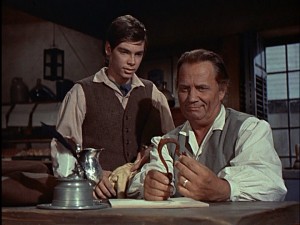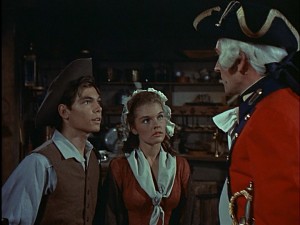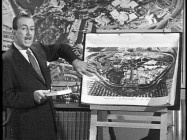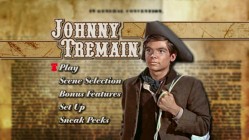Johnny Tremain is the product of a time when a film made for television could wind up in theaters and you'd not notice the difference. In 1957, when this Revolutionary War drama was released to theaters, Walt Disney was savvy enough to ensure that movies which made their debut on that living room staple, TV, had no stigma attached to them.
Our story begins in July of 1773 when Boston was more of a harbor town than a metropolis. There, the titular hero, Johnny Tremain (Hal Stalmaster), has a life more humble than he might recognize. A hardworking silversmith's apprentice, Tremain values the standing and stability of his master Ephraim Lapham (Will Wright) and his family of three. In an effort to complete an important (and potentially lucrative) job submitted by the Laphams' landlord Jonathan Lyte (Sebastian Cabot, who would later narrate The Many Adventures of Winnie the Pooh and voice Bagheera in The Jungle Book), Johnny breaks the Sabbath, which was clearly a severe transgression then for the religious colonial people. In the process of covering up his work, Johnny burns his right hand. This act would single-handedly (no pun intended) change his life, for without proper treatment, his fingers begin growing together. Too proud or stubborn to keep residence with the Laphams without pulling his weight financially, Johnny is quickly out looking for a new job.
As you might expect, a young man with a nonfunctional dominant hand is not in high demand. At this low point, Johnny decides to pursue something his mother told him before dying: that his middle name is "Lyte" and that he is indeed a relative of the pompous and prosperous Mister Jonathan of the same name. Not the least bit convinced, Mr. Lyte has Johnny arrested on the suspicion of stealing a family heirloom as part of his scam. Johnny winds up behind bars, but has the good fortune to have Josiah Quincy (Whit Bissell), one of the best lawyers in Boston, defending him. With Quincy's service and some testimony from his former master's daughter Cilla (Luana Patten in her first adult role for Disney, following a career as a child actor in films like Song of the South, So Dear To My Heart, and Fun and Fancy Free), Johnny walks free.


Still in need of a job, Johnny finds work as a one-handed horse-riding messenger boy for a publication called The Observer. This newspaper is the voice of the Sons of Liberty, a growing organization with members who are interested in obtaining basic rights for Americans. It is this new source of employment that pushes Johnny towards the American Revolution movement and makes his an historical story worth telling. It leads Tremain to the Boston Tea Party, where the Sons of Liberty, unconvincingly dressed as Indians, throw an extraordinary amount of tea off a boat into Boston Harbor, in protest of the British government's taxations and other activities. It is where the first of two installments neatly culminates for television airings.
The second half of the film begins in the spring of 1775 and one can assume Johnny's right hand has been surgically treated in the passed time, though it's never explicitly stated. This half of Johnny Tremain features more of the historically significant but at a cost: it's noticeably less engaging. It details the Sons of Liberty's progression towards battle, with too many specifics to appease historians and American Revolution buffs and not enough of the human drama that made Act One so fluid and captivating. By the time the film is done, rousing speeches have been given and some gunshots fired, and the viewer is still compelled by what is going on, but the potent emotional core seems to have come subservient to vague ideals and some dry facts.
Overall, Johnny Tremain is a noble and mostly enjoyable effort but one which demands your attention and sometimes struggles to retain it. With sharp dialogue and fine acting, the stately historical drama proceeds in an interesting and technically sound fashion. The film is even able to overcome one of its biggest drawbacks - namely, that it was clearly shot on a budget. This is evident in how much a film about taking action consists solely of talking, plus the liberal use of only partly-convincing matte work to make the sound stages appear like location shooting.


Johnny Tremain represents director Robert Stevenson's debut outing for Disney. It is the first of nineteen theatrically-released Disney films that put Stevenson at the helm. While Stevenson was the on-set shot-caller behind such studio hits as Old Yeller, Darby O'Gill and the Little People, Mary Poppins and The Love Bug, it's often difficult to distinguish his sensibilities from what is perceived as the general Disney "aesthetic." As such, Tremain feels like one of Walt Disney's early live action dramas and specific praises and criticisms are tough to pinpoint.
The film is adapted from Esther Forbes' award-winning 1940s account and while it reportedly takes a few dramatic licenses with the story, like most chapters of history that are more than two hundred years old, such inaccuracies are likely to be detected by an esoteric scholarly lot. For taking liberties, I wish that Tremain had gone further if it would render it a little less dry and static. Even with the budget limitations, the film teeters on the brink of truly rousing and inspiring art, but falls a bit short of timelessness.
 |
DVD
Details 1.33:1 Original Aspect Ratio (Fullscreen)
Dolby Digital Mono (English)
Subtitles: English; Closed Captioned
Release Date: August 2, 2005
Single-sided, dual-layered disc (DVD-9)
Suggested Retail Price: $19.99
White Keepcase
|
VIDEO and AUDIO
Johnny Tremain is presented in a 1.33:1 fullscreen transfer, but as it was filmed for television and then given theatrical release, that is the proper way to see the film. Clearly, it was framed with the 4x3 dimensions in mind, as the mise-en-scθne does not feel cramped or cropped in any way. Were you to matte the film to a mild widescreen ratio like, say the 1.75:1 ratio Disney was fond of, it looks like the framing would remain okay and the opening credits seem to leave a bit of room for potential theatrical matting. Disney probably could have released the DVD in either ratio, but Academy is the one that works the best and was surely originally in mind for the filmmakers; therefore, the fullscreen transfer is neither a sacrifice in quality nor part of the studio's often disconcerting trend of chopping up their old live action films for DVD with little regard.


As for the picture quality itself, it is rather pleasing, particularly for a nearly 50-year-old film, but even on its own regard. The biggest drawback is some grain, and rarely is there enough to distract. Other than this, the fine-looking transfer is quite the revelation, showcasing vibrant colors and sharp scenery, while displaying surprisingly few signs of age. Print intrusions are infrequent, with tiny digital artifacts and other blemishes turning up with refreshingly rare frequency. Just a few steps shy of perfection, the transfer illustrates one of the best treatments the studio has bestowed upon a '50s live action film.
Naturally, this '50s drama is presented with a two-channel Dolby Digital Mono soundtrack that most closely resembles its original theatrical exhibitions. Could a full-fledged surround remix have breathed some life into the film's few action sequences? It's possible, but the studio's "5.1 remixes" on live action fare have often come across like broad mono, and anything more than that, you wind up with knowledgeable purists taking them to task. As it is, I'd say this audio presentation is fine; it's not particularly surprising or crying out for comment. Dialogue almost always is intelligible, and the film's one catchy song is emphatically conveyed.



BONUS FEATURES and DESIGN
Unlike the eight previous catalogue DVDs Disney has released this year, Johnny Tremain thankfully boasts some bonus features. They're all of the vintage variety -- black-and-white footage from old television broadcasts -- but they feature the man behind it all, the magnetic Walt Disney himself.
First is "The Liberty Story: The Making of Johnny Tremain", an excerpt (22:12) of a 1957 episode of Walt's weekly "Disneyland" anthology series. Like the other TV specials centered on a new Disney film, this contains a number of clips from Johnny Tremain and could be viewed as rather shamelessly promotional, but Walt hosts charismatically, and it instead feels educational and entertaining. As a lead-in to the narrated film footage, Walt discusses liberty and heroism, using clips from 1952's The Story of Robin Hood as a springing ground. He also mentions plans inspired by the movie to add a "Liberty Square" area to the Disneyland theme park which would recreate 1775 Boston and pay tribute to those who secured basic rights for Americans. While this idea never came to fruition at Disneyland, it does exist at Disney World's Magic Kingdom, complete with a Liberty Tree. Unfortunately, the second part of this "Disneyland" episode, the 1953 animated short "Ben and Me" (which to date has not been released to DVD) is not retained.
In addition, there are Uncle Walt's two introductions from the "Disneyland" installments which broadcasted the film in 1958. The first (5:08), titled "Boston Tea Party", opens with Walt in a costume department praising unsung patriots like the movie's focus. The second (8:33), "The Shot that was Heard Around the World", finds Walt reflecting on the Revolutionary War's fight for human rights and then recapping the first installment (which had aired two weeks earlier) by narrating a number of key film clips.
The 16x9 menus use the same historical document background with different still artwork in front of it. They are each accompanied by different selections of the film's old-fashioned score. The disc opens with sneak peeks which play automatically and can easily be skipped. These previews are for Valiant, "Classic Family" live action movies on Disney DVD (that same promo seen on most catalogue releases of the past several years), the upcoming Timeless Tales cartoon compilation series, the Old Yeller: 2-Movie Collection, and Kermit the Frog's 50th Anniversary which is bringing Special Edition re-releases of The Muppet Movie, The Great Muppet Caper, The Muppet Christmas Carol and Muppet Treasure Island.


CLOSING THOUGHTS
In the late 1950s, Walt Disney could film something for television, have it wind up in theaters and still genuinely please crowds. The same cannot be done today, but Johnny Tremain does hold up as worthwhile entertainment. The first of two clearly-defined halves is the more engaging part of this historical drama, which ultimately loses sight of the title character (and others) in favor of ideals and a seeming adherence to fact. Overall, the film still merits a recommendation, especially for those with a penchant for early live action Disney productions and/or the American Revolution. Disney's long-anticipated DVD release thankfully delivers top-notch picture quality and a satisfying 35 minutes of Walt himself previewing and introducing the film to television audiences of the 1950s. While it's not in line with that wonderful but apparently discontinued Vault Disney line, it's a clear cut above most of the other catalogue discs the studio has released in recent years.
More on the DVD / Buy from Amazon.com












